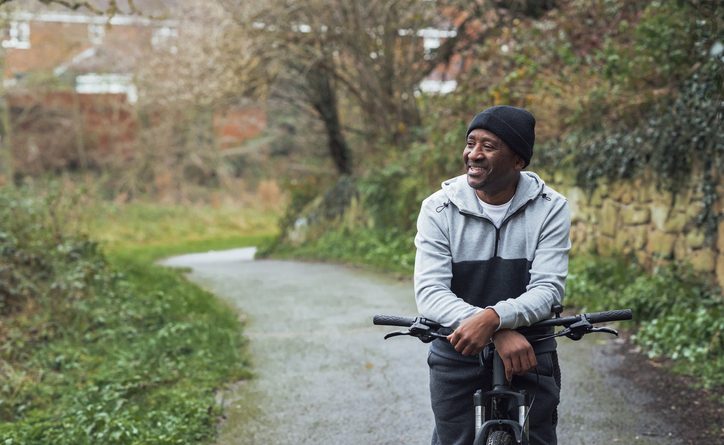Winter exercise tips
It’s important to retain your fitness when the weather turns chilly
By Betsy Butler, Ohio Public Employees Retirement System
Jan. 4, 2024 – It may be colder and cloudier outside, and the daylight is scarcer, but you can still stay active. Keep yourself motivated to reach your fitness goals until those glorious spring and summer days return.
Besides providing the expected benefits of physical fitness – such as getting a better night’s sleep, lowering blood pressure, improving balance, strengthening bones and muscles, and maintaining a healthy weight – winter exercise helps our mental health. Feeling less stressed and more relaxed is especially important when less sunlight can bring on seasonal affective disorder, a type of depression that some people experience during the winter months. It can also boost our immunity.
What’s more, lower temperatures can make you feel invigorated. Without the heat and humidity of summer, you may be more inclined to prolong your workout and burn more calories. Since your heart doesn’t have to work as hard and you sweat less, you can exercise more efficiently.
Cold-weather exercising doesn’t have to be a drag. Go for a brisk walk during your lunch hour. Besides getting some fresh air and exposure to natural light, you can enjoy the surroundings of nature. Raking leaves and shoveling snow bring seasonal opportunities to stay fit while tackling chores. Try enjoyable wintertime aerobic activities like skiing or ice skating. Take it easy at first, making sure your footwear supports your ankles. To help prevent injuries and falls, seek instruction for proper form.
Before exercising outdoors, consider a few tips:
Dress in layers to insulate you from the elements and keep you warm. Shed some of your clothing as your body warms up, and then don them again as air and body temperatures fluctuate. Sweating causes rapid heat loss, leaving you even chillier than before. Therefore, the layer closest to your skin should be a moisture-wicking material. Since cotton traps moisture, opt for lightweight synthetics like polyester that pull moisture away from the skin. Next, choose wool or polyester fleece for the second layer, which provides warmth and insulation. Keep a thin wind- and rain-repellent outer layer on hand for rest times; if it’s worn during exercise, it can trap sweat rather than help it evaporate properly.
If you’ll be out after dark, or before sunrise, opt for high-visibility reflective clothing. Make sure your footwear fits properly and offers sturdy traction to navigate slippery sidewalk conditions.
Wear a hat and gloves to keep heat from escaping through extremities. Add mittens or a liner under gloves if exercising in very cold conditions.
Don’t forget to apply sunscreen to exposed skin, including your lips, especially if surrounded by snow.
Ease into the chill by warming up first, including some stretching. To prepare your muscles and loosen your joints for what’s to come, perform a sequence of arm circles and swings, together with high steps and lunges. Spend more time than usual getting ready to exercise, as it takes longer to acclimate to the cold. Ramp up slowly to achieve your desired intensity, then incorporate a cool-down restorative period.
Stay hydrated before, during and after exercise.
Watch for hypothermia, a drop in body temperature that can cause serious health problems. Symptoms can include confusion, slurred speech, shivering, and cold feet and hands. Also, be alert to possible signs of frostbite, such as numbness and loss of feeling on exposed skin, such as your cheeks, nose and ears. If that occurs, get out of the cold and slowly warm the affected area.
If you judge the conditions to be too cold or wet to venture out, stay active indoors. At home, take regular exercise breaks throughout the day. Climb the stairs three to five times in a row, and work up from there. Do some vigorous housework, like vacuuming and sweeping. Create a simple place to exercise and outfit it with a yoga mat, resistance band and some dumbbells or simple household items with some weight to them, like canned goods. Tune into workouts offered online or a live Zoom session. Join an exercise or yoga class at a local fitness studio. Alternatively, head to a nearby shopping mall for either power-walking or a leisurely stroll past the stores.
Trade summer poolside lounging for indoor swimming. Take a water aerobics class or perfect your lap-swimming techniques.
Join an exercise group, or invite a friend to join you. Having company provides distraction from the weather, offers camaraderie, and helps you stay motivated.
Betsy Butler
Betsy Butler is the Ohio Public Employees Retirement System’s knowledge and issues strategist, researching information on pensions, retirement and health care. Betsy came to OPERS in 2009 after working as a special collections librarian for two OPERS employers: the Ohio History Connection and Miami University.
